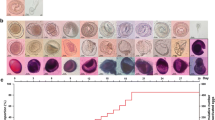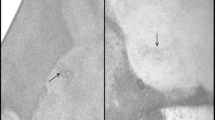Abstract
The effect of three routinely used disinfectants on the embryonary development of Toxocara canis eggs was evaluated both in vivo and in vitro. In the in vitro experiment, T. canis eggs were treated with the ethanol, sodium hypochlorite, and one commercial mix of benzalconium chloride and formaldehyde, and the embryonary development was assessed. After a period of 24 days incubation, ethanol was the best disinfectant because it prevented the development of the T. canis larvae 2 in the eggs, and sodium hypochlorite caused degeneration in 50% eggs. By using the commercial mix, 25% T. canis eggs developed to 2nd stage larvae. In the in vivo experiment, the embryonated eggs treated with the disinfectants were inoculated to mice, and their brain tissues were examined for larval presence on the 24th day postinfection. In addition, a control group was set up for comparison with the infected groups. No injury or T. canis larvae were observed in mice infected with sodium hypochlorite-treated eggs, opposite to that recorded in the animals infected with the commercial disinfectant-treated eggs. These results showed that both ethanol and sodium hypochlorite are very appropriate because of their full efficacy against infective T. canis eggs. Disinfection of kennels, animal shelters, cages, and veterinary clinics with one of these products to eliminate T. canis eggs and to avoid contamination is strongly recommended.
Similar content being viewed by others
References
Ayçiçek H, Yarsan E, Sarimehmetoðlu HO, Tanyüksel M, Girginkardeþler N, Özyurt M (2001) Efficacy of some disinfectants on embryonated eggs of Toxocara canis. Turk J Med Sci 31:35–39
Bardón R, Cuéllar C, Guillén JL (1994) Larval distribution of Toxocara canis in BALB/c mice at nine weeks and one year post-inoculation. J Helminthol 68:359–360
Chung LY, Fang BH, Chang JH, Chye SM, Yen CM (2004) The infectivity and antigenicity of Toxocara canis eggs can be retained after long-term preservation. Ann Trop Med Parasitol 98:251–260
Deutz A, Fuchs K, Auer H, Kerbl U, Aspöck H, Köfer J (2005) Toxocara-infestations in Austria: a study on the risk of infections of farmers, slaughterhouse staff, hunters and veterinarians. Parasitol Res 97:390–394
Fenoy S, Cuéllar C, Guillén JL (1996) Seroprevalence of toxocariasis in children and adults in Madrid and Tenerife, Spain. J Helminthol 70:109–113
Finch GR, Black EK, Labatiuk CW, Gyurek L, Beloseciv M (1993) Comparison of Giardia lamblia and Giardia muris cyst inactivation by ozone. Appl Environ Microbiol 59:3674–3680
Gamboa MI (2005) Effects of temperature and humidity on the development of eggs of Toxocara canis under laboratory conditions. J Helminthol 79:327–331
Havasiova K, Dubinsky P, Stefancikova A (1993) A seroepidemiological study of human Toxocara infection in the Slovak Republic. J Helminthol 67:291–296
Juris P, Breza M (1988) Trials with the disinvasive efficiency of some disinfectants in the laboratory conditions. Helminthologia 25:309–331
Kamiya M, Ooi HK, Nomura T (1987) The effect of radiation on the viability and migratory ability of second-stage larvae of Toxocara canis in mice. Vet Parasitol 24:87–92
Korich DG, Mead JR, Madore MS, Sinclair NA, Sterling CR (1990) Effect of ozone, chlorine dioxide, chlorine and monochloramine on Cryptosporidium parvum oocyst viability. Appl Environ Microbiol 56:1423–1428
Ooi HK, Lin CL, Wang JS (1998) Effect of ozone treatment on Toxocara canis eggs. J Vet Med Sci 60:169–173
Satou T, Horiuchi A, Akao N, Koike K, Fujita K, Nikaido T (2005) Toxocara canis I: search for a potential drug amongst B-carboline alkaloids in vitro and mouse studies. Exp Parasitol 110:134–139
Suárez JL, Díez-Morrondo C, Sánchez-Andrade R, Romasanta A, Sánchez-Andrade A, Paz A, Díez-Baños P, Morrondo P (2005) Detección de anticuerpos frente a Toxocara canis en pacientes con eosinofilia. Acta Parasitol Port 12:437–438
World Health Organization (1993) Guidelines for drinking-water quality, 2nd edn, vol. 1 Recommendations
Acknowledgement
We thank B. Valcárcel for reading the manuscript.
Author information
Authors and Affiliations
Corresponding author
Rights and permissions
About this article
Cite this article
Morrondo, P., Díez-Morrondo, C., Pedreira, J. et al. Toxocara canis larvae viability after disinfectant—exposition. Parasitol Res 99, 558–561 (2006). https://doi.org/10.1007/s00436-006-0200-5
Received:
Accepted:
Published:
Issue Date:
DOI: https://doi.org/10.1007/s00436-006-0200-5




